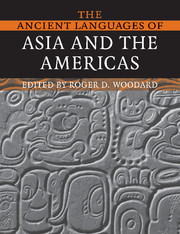Book contents
- Frontmatter
- Contents
- List of figures
- List of tables
- List of maps
- List of contributors
- Notes on numbering and cross-referencing
- List of abbreviations
- Preface
- Preface to the first edition
- 1 Language in ancient Asia and the Americas: an introduction
- 2 Sanskrit
- 3 Middle Indic
- 4 Old Tamil
- 5 Old Persian
- 6 Avestan
- 7 Pahlavi
- 8 Ancient Chinese
- 9 Mayan
- 10 Epi-Olmec
- Appendix 1 Reconstructed ancient languages
- Appendix 2 Full tables of contents from The Cambridge Encyclopedia of the World's Ancient Languages, and from the other volumes in the paperback series
- Index of general subjects
- Index of grammar and linguistics
- Index of languages
- Index of named linguistic laws and principles
9 - Mayan
Published online by Cambridge University Press: 01 September 2010
- Frontmatter
- Contents
- List of figures
- List of tables
- List of maps
- List of contributors
- Notes on numbering and cross-referencing
- List of abbreviations
- Preface
- Preface to the first edition
- 1 Language in ancient Asia and the Americas: an introduction
- 2 Sanskrit
- 3 Middle Indic
- 4 Old Tamil
- 5 Old Persian
- 6 Avestan
- 7 Pahlavi
- 8 Ancient Chinese
- 9 Mayan
- 10 Epi-Olmec
- Appendix 1 Reconstructed ancient languages
- Appendix 2 Full tables of contents from The Cambridge Encyclopedia of the World's Ancient Languages, and from the other volumes in the paperback series
- Index of general subjects
- Index of grammar and linguistics
- Index of languages
- Index of named linguistic laws and principles
Summary
HISTORICAL AND CULTURAL CONTEXTS
Linguistic prehistory and history
The language described herein as Mayan is known from a hieroglyphic script that was employed in a large region in Mesoamerica, encompassingmuch of what is today southeastern Mexico, northern and eastern Guatemala, all of Belize, and the western part of Honduras. The earliest securely dated and geographically provenienced hieroglyphic text from this region is Stela 29 from Tikal in northeastern Guatemala, which bears a date of 6 July AD 292. The script was in continuous use in this region until the second half of the sixteenth century, when it was replaced by the Latin-based alphabet introduced by the Spaniards.
Lyle Campbell and Terrence Kaufman (1985) have classified the thirty or so Mayan languages in terms of five branches, each of which is further divided into groups and subgroups (Fig. 9.1). At the time of the Spanish Conquest, the inhabitants of the region where hieroglyphic texts have been found spoke languages representing the Yucatecan and Greater Tzeltalan groups (Fig. 9.2). The Yucatecan languageswere confined to the Yucatan peninsula in the north. South of them was a broad band of Cholan languages, running from Chontal and Chol in the west to Cholti and Chorti in the east. Tzeltal was the only language in Tzeltalan Proper that was spoken in the region under consideration.
Kaufman's (1976) glottochronological estimates suggest that by AD 292 Yucatecan had already separated from Huastecan, and that Cholan and Tzeltalan Proper had already differentiated from each other.
- Type
- Chapter
- Information
- The Ancient Languages of Asia and the Americas , pp. 163 - 192Publisher: Cambridge University PressPrint publication year: 2008
- 1
- Cited by



